- Laboratoire Univers et Particules de Montpellier, CNRS/Université de Montpellier, Montpellier, France
Cosmic rays (CRs) are accelerated in diverse astrophysical objects like supernova remnants, massive star clusters, or pulsars. Fermi acceleration mechanisms built a power-law distribution controlled by the ratio of the acceleration to escape timescales in the acceleration site. Hence, escape is an essential mechanism to establish the particle distribution at cosmic-ray sources and to control the flux of cosmic rays injected into the galaxy. Different models have tried to account for the escape process. However, all show some limitations due to the complexity of the particle release mechanism, usually involving 3D geometry, with specific magnetic turbulence properties linked to the process itself. The escape process is also time dependent and results from the interplay of particle acceleration and injection efficiency in the astrophysical source. Once injected into the interstellar medium, freshly released particles are channelled by the ambient magnetic field, which is itself turbulent. In a simplified view, we mainly focus on the propagation of CRs along 1D magnetic flux tubes before turbulent motions start to mix them over a turbulent coherence length, and then we further question this assumption. Close to their sources, one can also expect cosmic rays to harbour higher pressure with respect to their mean value in the interstellar medium. This intermittency in the CR distribution is prone to trigger several types of kinetic and macro instabilities, among which the resonant streaming instability has been the most investigated. In this article, we review recent observational and theoretical studies treating cosmic-ray escape and propagation in the vicinity of their source. We will consider three main astrophysical contexts: association with massive star clusters, gamma-ray halos around pulsars, and, more specifically, supernova remnants. In particular, we discuss in some detail the cosmic-ray cloud (CRC) model, which has been widely used to investigate CR propagation in the environment of supernova remnants. The review also discusses recent studies on CR-induced feedback over the interstellar medium surrounding the sources associated with the release process, as well as alternative types of driven instabilities.
1 Scientific context
The origin of the cosmic ray (hereafter CR) phenomenon is still a widely open issue in modern astrophysics. CRs are mostly composed of protons and helium nuclei, plus some traces of heavier elements. The CR spectrum also has a leptonic component dominated by electrons. Several sources likely contribute to the CR spectrum observed on Earth: citing a few of the most-invoked ones, supernova remnants (SNRs), massive star clusters (MSCs), and pulsars and their nebula, see Gabici et al. (2019) and references therein. There is clear observational evidence from radio to X- and gamma-ray wavebands that these sources accelerate non-thermal particles; the highest energies reach several tens to hundreds of TeV (Vink and Bamba, 2022; Tibaldo et al., 2021; Bykov et al., 2020; Funk, 2015). The CR energy spectrum at sources is harder,
In addition to understanding the link between CRs in sources and in the local ISM, it is also important to realise that CRs can have much dynamical feedback over ISM dynamics. First, CRs can have a dynamic role because of their pressure and the gradient of their pressure (Ruszkowski and Pfrommer, 2023; Zweibel, 2013). In the local ISM, this role is devoted to particles with kinetic energies close to 1 GeV due to the softness of the above-mentioned spectrum. The local ISM CR pressure
CR-modified propagation around their sources has been discussed in several astrophysical contexts: around SNRs, around MSCs, at the galactic centre, and to explain the gamma-ray halo phenomenon around evolved pulsars. The evidence for such modification (which must be understood with respect to the diffusive regime derived from secondary to primary, or S/P, ratio studies) starts to have a better observational basis, itself completed by a diversity of models from purely phenomenological to models involving plasma microphysics. Gamma-ray data can be used to support the CR-modified propagation in the environment of sources (Mitchell et al., 2021). Reduced diffusion coefficients are derived from the radial fit of the gamma-ray profile applied around a given source. In most of the cases, the fit assumes a constant but reduced diffusion coefficient (one-zone model), a continuous particle injection from a point source and no advective transport [see, e.g., the cases of Cygnus cocoon and Westerlund 1 MSCs in Aharonian et al. (2019)]. The solution of the transport CR equation in spherical geometry gives a particle profile
Before discussing specific observations, let us specify some technical aspects of the models used in these analyses. First, there are two ways CRs can be injected in a halo, either continuously with time or at a given time, in a burst-like way. Most of the below-analysis adopt a burst-like injection, which means that a particle with a given energy is injected at a given time t, as has been modelled in Ohira et al. (2011) and more accurately described in Section 2. Second, the CR transport equation is usually treated in spherical geometry, as again done by Ohira et al. (2011). But some approaches use a Cartesian geometry and allow for anisotropic particle diffusion along two directions: a parallel diffusion described by a specific diffusion coefficient
1.1 Supernova remnants
Uchiyama et al. (2012) investigate the GeV gamma-ray emission detected by the Fermi-LAT from molecular clouds in the vicinity of the SNR W44. The CR model is adapted from Ohira et al. (2011). CRs are injected in a burst-like manner. Reduced diffusion solutions are possible with
Using both GeV and TeV data and an isotropic spherical diffusion model with burst-like injection, Hanabata et al. (2014) propose
These two first studies triggered several others with diverse conclusions: The MAGIC collaboration (MAGIC Collaboration et al., 2023) fits extended emission around the
1.2 Massive star clusters
Aharonian et al. (2019) use Fermi, HESS, and ARGO data to investigate the extended emission around the Westerlund 1 massive star cluster, around the Arches, Quintuplet clusters in the central molecular zone, as well as the Cygnus cocoon. In each case, the radial profile of the gamma-ray emission shows a 1/r decline within 50 pc around the central source. The objects also show an energy spectrum scaling as
1.3 Gamma-ray halos around pulsars
Gamma-ray halos around evolved pulsars are a new phenomenon detected in the GeV and multi-TeV bands. This shows extended diffuse structures of several pc scales; hence, they are much extended compared to the pulsar wind nebula. López-Coto et al. (2022) propose a review of the gamma-ray halo phenomenon based on the discovery of Geminga and Monogem pulsar halos. Fang (2022) proposes a complement to this list, including two more objects, namely, LHAASO J0621 + 3,755 [see also Liu (2022)] and HESSJ 1831-098. For each of these objects, the gamma-ray profile centred on the pulsar and its nebula (whose extension is small with respect to the halo), a spherical gamma-ray profile either in the GeV or multi-TeV range fits a
In this short review, we first detail in Section 2 the kinetic models describing cosmic-ray escape from their sources and then present the cosmic-ray cloud (CRC) model. We consider three types of sources: supernova remnants, massive star clusters, and pulsars through their gamma-ray halos. Then, Section 3 describes the potential dynamical effects associated with CR pressure and current effects. The effects due to ionisation are also invoked in this section. Section 4 concludes and proposes some perspectives.
2 Cosmic-ray halos: theoretical aspects
2.1 Acceleration and escape models
Modified CR propagation is usually invoked in the framework of CR self-generated turbulence; that is, CRs can produce the turbulence that they scatter off. However, specific local properties of a background (or extrinsic) turbulence can also explain, to some extent, the gamma-ray and CR halo phenomena. We now examine these two possibilities in more detail.
The first step for the production of a CR halo comprises the escape of these particles from the accelerator. One could define a CR halo as a cloud of energetic particles confined in the close spatial and temporal environment of a source (the spatial and temporal extension of the cloud need to be properly estimated) but disconnected from the acceleration process [see Malkov et al. (2013) for more discussion]. Let us illustrate the properties of a halo in the case of SNRs. The above definition is, in fact, a bit arbitrary. Indeed, in the diffusive shock acceleration process, likely at the heart of the acceleration of CRs, a more correct approach would be to consider that the most energetic particles have a 3D random walk and a probability to return to the shock, which is dropping to 0, as discussed by Drury (2011). This description, however, requires a minimum level of extrinsic turbulence to allow particles close to the maximum energy to not freely escape; otherwise, the escape process is controlled by the energy flux carried by the highest CR to bootstrap the acceleration process (Bell et al., 2013); (Blandford et al., 2023). However, 3D modelling of the escape process is out of reach of current computational resources. The authors are reduced to adopting a 1D spatial description in which the escape process is controlled by a physical boundary (named the far escape boundary) or even simply setting a maximum energy; see the discussion in Reville et al. (2009). Physically, this boundary may mark the transition between a zone where the presence of CRs triggers a magnetic dynamo and the interstellar medium (Xu and Lazarian, 2022b). Notice that CRs can also escape from downstream if, for instance, the turbulence level drops (Ptuskin and Zirakashvili, 2005.
Several models have attempted to describe the escape process and the transition from the in-source to around-source CR distribution. These models focus on SNRs. In these approaches, the maximum CR energy
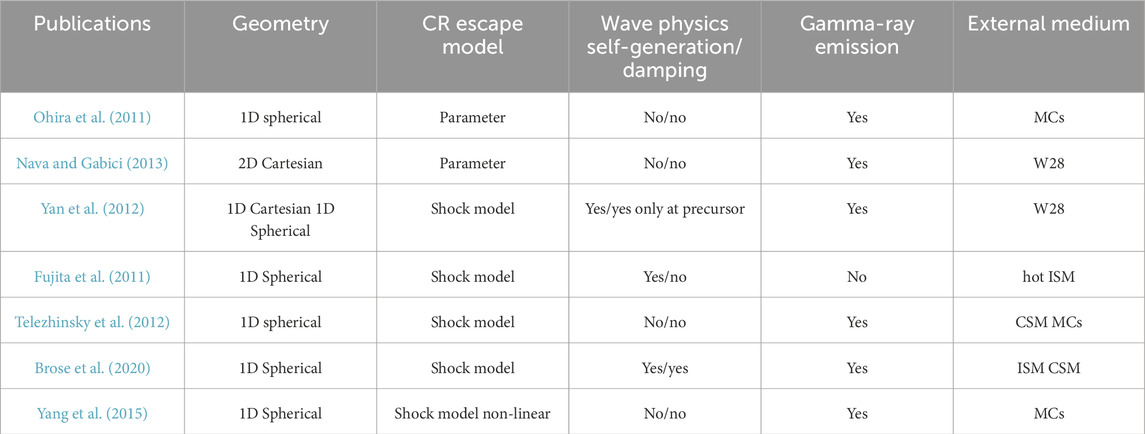
Table 1. Main physical assumptions and background medium properties of several CR escape models from SNRs in order of appearance in the text. MCs: molecular clouds, ISM: interstellar medium, and CSM: circumstellar medium.
Ohira et al. (2011) consider the case of SNRs close or in interaction with molecular clouds (MCs). They use a 1D spherical model and introduce a parameterised form for
Nava and Gabici (2013) propose a similar model using 2D cylindrical geometry. In this model, the maximum CR energy is also parameterised as by Ohira et al. (2011) but with
Yan et al. (2012) propose a 1D Cartesian model for the CR precursor ahead, the SNR shock. They accurately derive a value for
Fujita et al. (2011) adopt a 1D spherical two-zone model: a shock zone corresponding to a CR precursor and an escape zone where particles at high energy move diffusively with a diffusion coefficient derived from quasi-linear theory (or QLT, see next). The coefficient includes the amplitude of the self-generated waves. In each zone, an equation for the self-generated waves is solved using a quasi-linear expression for the growth rate. The authors consider three types of models: A, B, and C. Model A corresponds to the general case where the amplitude of the waves is derived in parallel to the evolution of the CR distribution; models B and C are used as tests. In model B (C), the diffusion coefficient is fixed to its Bohm value (the amplitude of the wave is fixed). In all cases, there is no explicit calculation for
Telezhinsky et al. (2012) include a treatment of particle acceleration at the SNR shock in 1D spherical geometry, including hydrodynamics of fluid evolution. The model can hence derive a physically based expression for
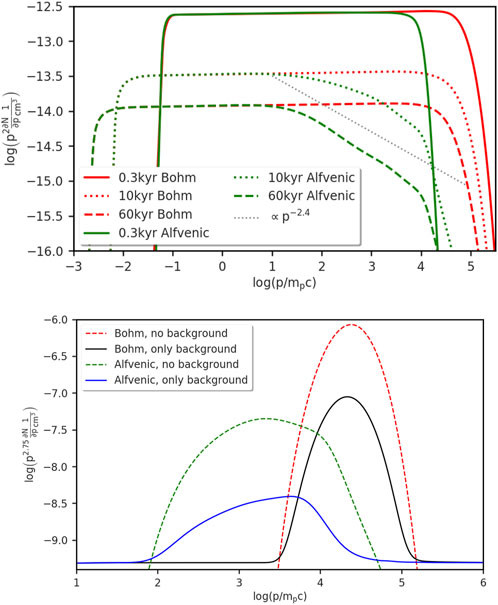
Figure 1. CR distribution over the whole volume of integration (up) and a particular distance of 7.5 pc from the SNR (down) for different models (see text for details). From Brose et al. (2020).
Yang et al. (2015) also elaborate on Telezhinsky et al. (2012) but go beyond the test-particle limit by including non-linear effects over magnetohydrodynamics of shock solutions following the numerical recipes by Zirakashvili and Ptuskin (2012). The authors propose a calculation of the CR distribution outside the acceleration zone by modulating the escaped CR distribution (so a distribution based on a non-linear acceleration model) by the kernel obtained from the 1D spherical solution of the diffusion equation. This is their model B. Their model A is similar to the approach adopted by Telezhinsky et al. The main trend of the results, regardless of age and distance (up to 100 pc ahead of the SNR), is that model A leads to a moderately enhanced CR component with respect to model B, which includes non-linear effects in the source. The difference is, at most, one order of magnitude in the energy flux.
A recent analysis considered the escape of CRs from SNRs propagating in the Parker spiral produced by a massive progenitor star (Kamijima and Ohira, 2022). Test-particle solutions show that the energy of escaping particle
At this stage, an alternative approach combines acceleration, escape, and transport in the ISM. In this model, Petrosian and Chen (2014), instead of adjusting data with model parameters, revert the analysis by using CR data from sources and direct measurements to infer the CR momentum diffusion coefficient and angular scattering frequency. The authors concentrate their analysis on electron spectra (for instance, from SNR RXJ1713.7–3946 or SN 1993J). They conclude that it is likely that complex relationships beyond a simple random walk should link escape and scattering times, possibly invoking the presence of stochastic interaction with compression perturbations, as discussed in Section 2.3.8.
Summarising briefly, the aforementioned models all tend to show that an SNR can inject a CR distribution harder than the background ISM population over relatively long timescales of a few tens of kyr. When self-generated waves are included, the confinement of particles is reduced with respect to the case of prescribed transport [see, e.g., Brose et al. (2020)], that is, by fixing a reduced factor
We now turn to the cosmic-ray cloud (CRC) model, which is a different class of model. These are 1D Cartesian. They calculate the propagated CR spectrum along a magnetic flux tube surrounding the mother source and provide a parallel solution of the self-generated wave spectra. In some senses, CRC models are less accurate about the escaping process from the accelerator but propose a more accurate treatment of the propagated particles once these are disconnected from the acceleration process. Notice that assuming a population of particles can be completely disconnected from acceleration processes occurring at the SNR is the main assumption of the CRC model. The assumption somehow hides the physics of escape and, hence, the transition from in-source to near-source propagation. This subject is still open, and the above-described models only treat this aspect in a phenomenological way. In reality, this issue requires a refined modelling of the microphysical processes responsible for this transition [see discussions in Malkov et al. (2013) and Bykov et al. (2017)].
2.2 The cosmic-ray cloud model
The cosmic-ray cloud model has been developed by Ptuskin et al. (2008) and Malkov et al. (2013). In this model, CR acceleration and escape phases are decoupled, and acceleration is not explicitly treated separately in the construction of the CR injection term
2.2.1 Model equations
The complete set of the CR-wave diffusion-convection equations is given by Schwartz and Skilling (1978) and Dewar (1970). We consider only waves propagating along the background magnetic field (slab waves); hence:
If we restrict ourselves to a 1D description with a spatial variable along z, then
At this stage, it should be clear that CR resonant scattering in the quasi-linear regime is a rather restricted way of describing the propagation of CRs in magnetic turbulence. We also neglect CR perpendicular transport completely at this point [see, e.g., Zhang and Xu (2023) and Xu (2021) for recent investigations]. For the wave growth rate, we restrict ourselves for now to the case of the resonant streaming instability, although many other instabilities are possible (see Section 3). In the quasi-linear limit, the wave growth rate is proportional to the CR pressure gradient along the background magnetic field (Skilling, 1975; Marcowith et al., 2021).
where
The damping rate depends on the ISM environment. In ionised phases, wave damping can be due to linear damping (LD), non-linear Landau damping (NLLD), or turbulent damping (TD). The latter is due to the non-linear interaction of self-generated waves with background perturbations part of large-scale-injected turbulence. In partially ionised phases, rapid ion-neutral collisions (IND) take over the other processes (see the next sections for further discussion on these damping processes).
An important quantity in the CRC model is the adimensional variable
This quantity is conserved along the magnetic flux tube in which CRs propagate. CR and wave pressure equations can be solved simultaneously either using semi-analytical calculations (Malkov et al.. 2013 or numerically (Nava et al., 2016; Brahimi et al. 2020).
2.2.2 Model physics
The model requires some assumptions about the injection spectrum

Figure 2. Sketch of the CRC model: at a time t, CRs are injected on the left side of the magnetic flux tube. The SNR expands at a speed
Another important quantity is the half-life of the CRC,
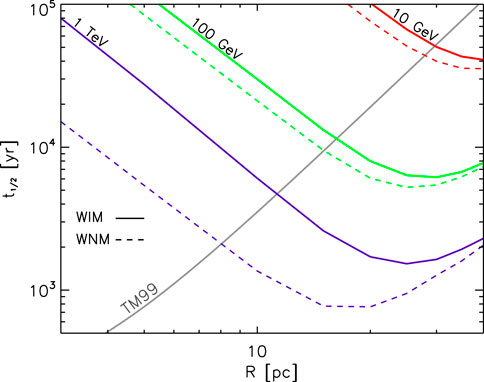
Figure 3. Solutions for the CRC half-life
where
The next section discusses applying the CRC model to different ISM phases.
2.3 Astrophysical models for SNR halos
2.3.1 Interstellar medium phases
In Table 2, we briefly summarise the physical properties of the ISM phases, namely, different regions of the ISM characterised by specific thermodynamical quantities like density, temperature, or ionisation fraction (McKee and Ostriker, 1977; Cox, 2005). These quantities will be helpful in estimating the different damping rates.
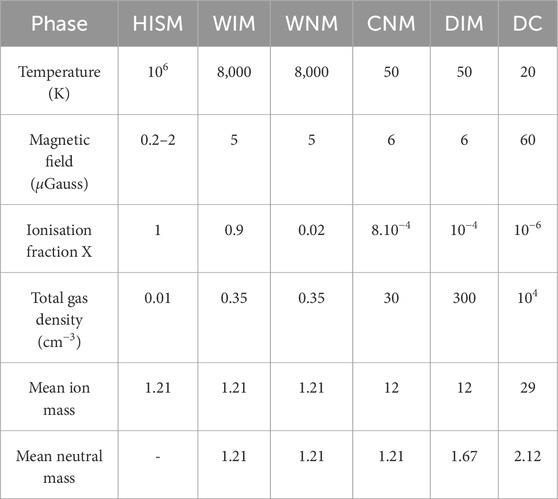
Table 2. Mean thermodynamical properties of the different ISM phases. HISM: hot ISM, WIM: warm ionised medium, WNM: warm neutral medium, CNM: cold neutral medium, DIM: diffuse molecular, and DC: dark clouds. Notice that the molecular phase is decomposed into DIM and DC. The different values are extracted from Jean et al. (2009), Snow and McCall (2006), and Neufeld et al. (2005). The total gas density is the sum of ion density
2.3.2 Damping processes
Ion-neutral damping does not operate in ionised phases. The main mechanisms responsible for CR-driven wave damping are linear and non-linear Landau damping and turbulent damping. Linear Landau damping (LD) involves the damping of collective plasma motion by the resonant interaction with thermal background plasma (thermal ions). This damping does not affect the Alfvén slab modes considered here but does affect magnetosonic waves [see Yan and Lazarian (2004)].
Non-linear landau damping (NLLD) is a process that can be viewed as the non-linear interaction of two (here Alfvén) waves with a thermal particle (Hasegawa, 1975). Calculations of the NLLD rate can be found in Lee and Völk (1973) and Hollweg (1971). We use the expression from Wiener et al. (2013),
where
As previously stated, turbulent damping occurs because of the interaction of CR-driven waves with background turbulence injected at large-scale L of the ISM (Farmer and Goldreich, 2004; Lazarian, 2016; Xu and Lazarian, 2022a; Cerri, 2024). A general expression is
Viscous (collisional) damping effects do not affect slab Alfvén wave cascades (Jean et al., 2009).
As stated above, because we are dealing with resonant wave-particle interaction, for slab-type Alfvén waves, we will hereafter apply a direct relation between the wave number and the particle Larmor radius (taken in the background magnetic field
Ion-neutral collisions can affect CR-driven Alfvén waves in a partially ionised phase (in fact, ion-neutral damping is already relevant in the warm ionised medium (WIM) phase). The damping rate is fixed by the ordering of the phase frequency
T is the gas temperature. In molecular phases, it is
More accurate estimations that include the contribution of helium can be found in Recchia et al. (2022). Ion-neutral collisions most efficiently damp high-frequency waves with
The Alfvén wave is ported by the ions and is expressed as
Because ions and neutrals move in phase in this regime, the Alfvén speed includes the contribution of neutrals,
2.3.3 Results in the fully ionised phase
CR clouds propagating in fully ionised phases have been treated by Nava et al. (2019). In the HISM phase, the adiabatic phases of the SNR expansion last over much longer timescales than in other media. It may even happen that the SNR merges with the ISM before reaching any radiative phases, as the upstream sound speed is much higher there, namely,
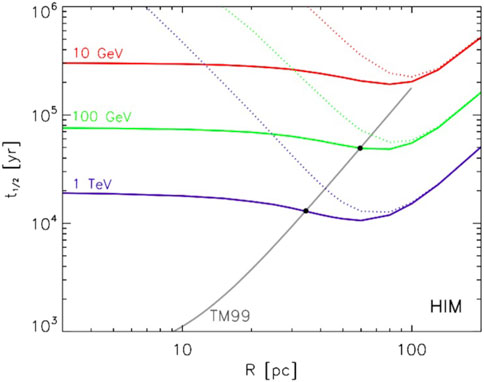
Figure 4. CRC half-life in the HISM phase. Red, green, and purple curves refer to CR energies at 10 GeV, 100 GeV, and 1 TeV, respectively. Dotted lines are the solutions if only the turbulent damping is included, whereas the solid lines combine the contribution of both turbulent and non-linear Landau damping processes. The grey curve depicts the SNR shock dynamical solution obtained in Truelove and McKee (1999). From Nava et al. (2019).
Figure 5 displays the time evolution of the CR spectrum (upper figures) and the spatial parallel diffusion coefficient (lower figures, reported as the diffusion coefficient deduced from direct CR measurements) as a function of CR energy. From this figure, one can clearly see the time sequence of CR escape, with the highest energies escaping first. The diffusion coefficient can be non-linearly reduced over a broad range of CR energies up to one order of magnitude, especially closer to the cloud centre (left figures). At larger distances, the final CR spectrum is softer than the injected one (
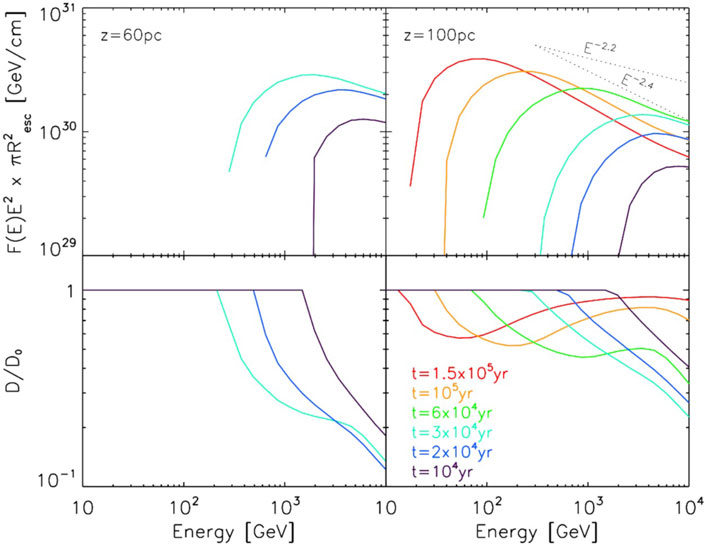
Figure 5. Upper figures: Time-dependent CR spectrum at two distances from the cloud centre: 60 pc (left) and 100 pc (right). Lower figure: Time-dependent evolution of the self-controlled parallel spatial diffusion coefficient as a function of the CR energy. The coefficient is normalised to the background diffusion
2.3.4 Results in partially ionised phases
As stated above, the wave growth in partially ionised phases is mainly controlled by ion-neutral collisions. Ion-neutral damping depends on the perturbation frequency. At high frequencies, Equation 6 applies, whereas Equation 7 applies at low frequencies. As we are dealing with resonant wave-particle interaction, for slab-type Alfvén waves, we have
Globally, partially ionised phases lead to less confinement, especially at low energies (10–100 GeV), because the damping rate is maximal. Figure 6 presents the space dependence of the CR pressure, the CR pressure gradient, and the wave spectrum amplitude and diffusion coefficient values in the CNM phase (Brahimi et al., 2020). The zone over which modified propagation extends is typically up to a few tens of pc, while the diffusion coefficient is reduced by factors up to 100 but for a limited time. The larger extension of the modified propagation zone at TeV can be explained because of the high CR gradient associated with a small CR cloud radius and because resonant waves are in the coupled regime in this energy regime; hence, the ion-neutral damping rate is reduced and scales as
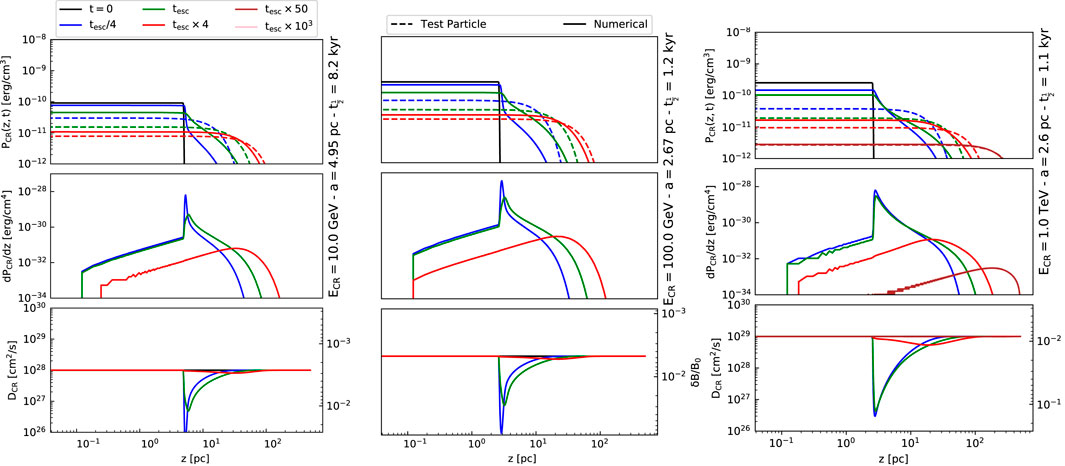
Figure 6. CR pressure (upper row), pressure gradient (middle row), relative diffusion coefficient, and wave amplitude (lower row) at three different CR energies (left: 10 GeV, middle: 100 GeV, and right: 1 TeV) if the SNRs propagate in the CNM. The cloud half-lives are 8.2 kyr, 1.2 kyr, and 1.1 kyr at 10 GeV, 100 GeV, and 1 TeV, respectively. In each case, the escape radius
2.3.5 Grammage around CR sources
As CRs harbour a reduced diffusivity around SNRs, a substantial fraction of their grammage (the amount of matter intercepted during their journey to the Earth) could be due to these peculiar regions of the ISM (D’Angelo et al., 2016). This aspect could potentially affect the interpretation of secondary to primary ratio in direct measurements. Using a CRC model, D’Angelo et al. (2016) infer such a vicinity source grammage as a function of the fraction of neutrals from a completely ionised medium to a medium composed of approximately 10% of neutrals. The model considers a CR population released with an energy spectrum of
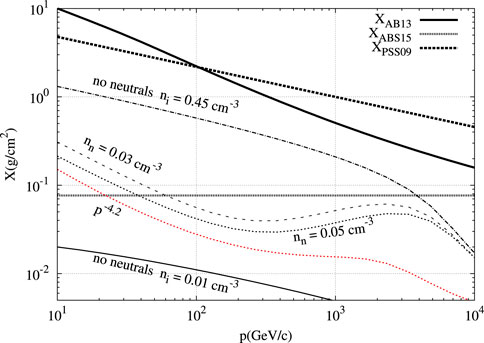
Figure 7. Near-source grammage as a result of the triggering of the resonant streaming instability. The solid thick line is the grammage inferred in Aloisio and Blasi (2013), the dotted line is from Ptuskin et al. (2009), and the light dotted line is from Aloisio et al. (2015). The different ISM models are: (1) thin solid line: no neutrals and ion density
Nava et al. (2019) similarly find that the nearby-source grammage does not contribute more than
2.3.6 Cases of inhomogeneous interstellar medium
The discussion in the previous sections was restricted to a homogeneous ISM. In reality, the ISM is all but homogeneous, especially in the galactic disc, close to star formation sites. The inhomogeneous character of the ISM can modify the CRC model in several ways. First, depending on the position in the disc, the coherence scale of the large-scale-injected turbulence can vary from a few parsecs in spiral arms to typically 100 parsecs in inter-arm regions [see, e.g., Haverkorn et al. (2008)]. Then, if immersed in different phases, the ionisation fraction can substantially vary along the magnetic flux tube. In addition, a variation of the magnetic field strength and gas density induces a variation of the local Alfvén speed and hence inflicts supplementary adiabatic losses to CRs while they propagate (see the second term in the RHS of Equation 1).
We provide here an example of a simulation combining different ISM phases (see Brahimi et al. (2020), see also1). In Figure 8, we present a test comprising several ISM phases along the magnetic flux tube, namely, WNM, CNM, and diffuse molecular (DIM) phases. CNM and DIM phases cover 80 pc and 20 pc, respectively, while the WMN phase in which the SNR is embedded covers 100 pc. Of course, it is quite debatable to assume a flux to be conserved over such large distances [i.e., more than 200 pc; see discussions in Chandran (2000)], but this set-up must be rather seen as a test bed case. What can be noticed from this figure is first that the presence of the DIM phase is almost imperceptible. Then, it can be noted that adiabatic losses can have an effect on the CR distribution. At low energies, the term
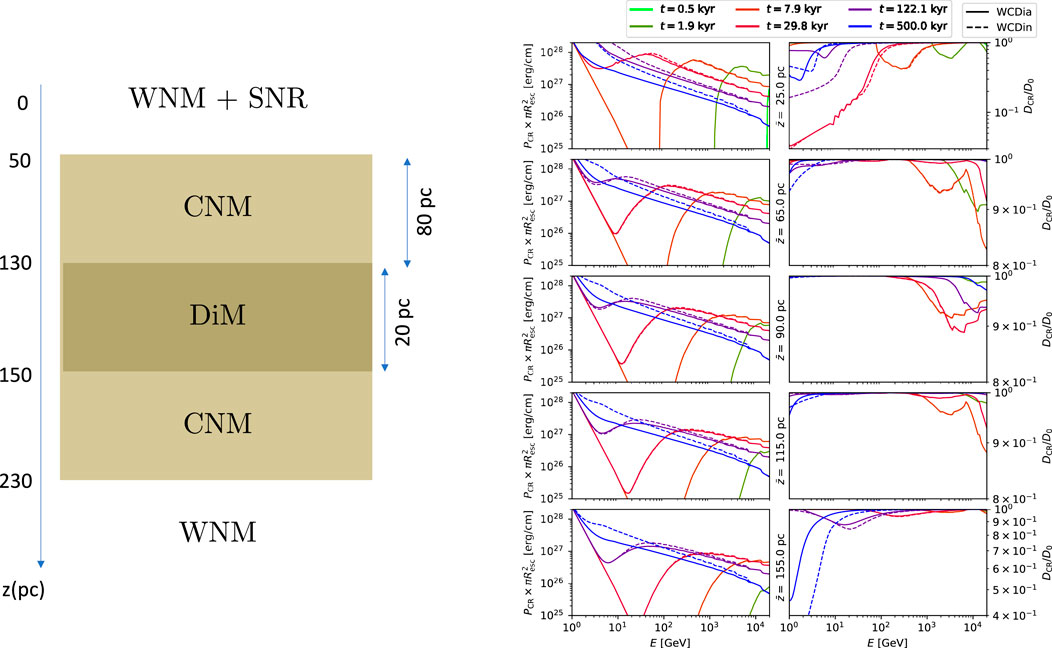
Figure 8. CR escape in an inhomogeneous ISM setup. Left panel: Inhomogeneous ISM sketch: the SNR is placed in a WNM phase, while the magnetic flux tube along which propagated CRs pass by a succession of CNM-DIM-CNM sequences. Right panel: CR pressure and diffusion coefficients as a function of the CR energy at six different times and five different distances from the SNR corresponding to the WNM, CNM, DIM, CNM, and WNM phases, respectively. The CR pressure is multiplied by the surface of the flux tube at the escape time. The CR diffusion coefficient is normalised to the background diffusion coefficient. Two setups are displayed: WCDia and WCDin. WCD designs the phase sequence WNM-CNM-DIM; (i) means that the background CR diffusion is independent of the ISM phase, (a) means that all terms in Equation 1 are retained, and (n) means that the energy terms are skipped. From L. Brahimi’s PhD Thesis.
2.3.7 The release of low-energy cosmic rays
In the previous sections, we have limited our analysis to CR energies larger than 10 GeV. However, the release of less energetic particles in the ISM must also be properly addressed. In effect, protons with MeV kinetic energies or electrons with sub-keV kinetic energies are the main drivers of ISM non-thermal ionisation (Padovani et al., 2009). In addition to ionisation, GeV protons are involved in MeV gamma-ray line production, whereas keV electrons are involved in iron line fluorescence emission (Tatischeff, 2003).
The release of low-energy CRs in the CRC model framework has been considered by Jacobs et al. (2022). In this model, ionisation/Coulomb losses are taken into account for low-energy particles and pp interaction for high-energy particles. The wave equation (Equation 2) also accounts for the damping due to self-interaction between waves involved in a self-generated turbulent cascade. Ion-neutral and turbulent damping terms are also included in the wave equation. CRs are released before, or at most at the start of, the radiative evolution phase of the SNR and carry 10% of the ejecta kinetic energy. We describe the main results below.
Figure 9 presents the CR distribution and diffusion coefficients in the case of an SNR propagating in two different phases, namely, the WIM and WNM phases. It appears that the timescales over which the CR diffusion coefficient is modified due to non-linear effects induced by self-generated turbulence are longer than for higher energetic particles (see Nava et al. (2016) for a comparison): the diffusion coefficient can be reduced by approximately one order of magnitude over several hundred kyr after the release over distances of several tens of parsecs. This has some important consequences for the uniformity of low-energy CRs in our galaxy. Contrary to multi-GeV and TeV CRs, multi-MeV particles do have a much more intermittent distribution. This means that the fit of Voyager data must be interpreted in a statistical sense (Phan et al., 2023), but solutions exist which fit these data. The grammage at energies below 1 GeV is found to be enhanced, in particular in the WIM phase, where it reaches approximately 0.8
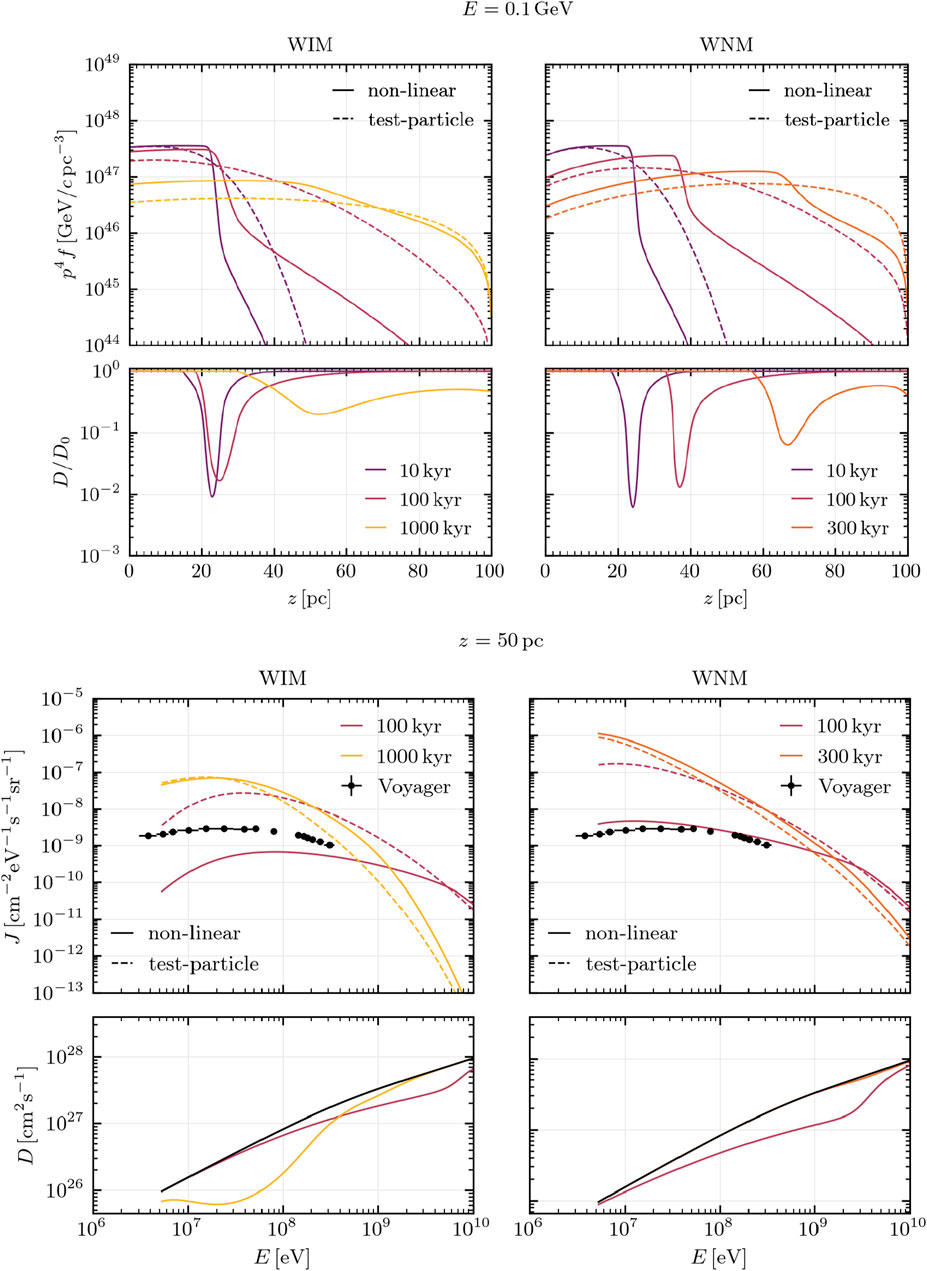
Figure 9. CR distribution (upper row) and normalised diffusion coefficients (lower row) for 100 MeV CRs at three different times in the WIM (left) and WNM (right) phases, respectively. CR distribution (upper row) and normalised diffusion coefficients (lower row) are plotted as a function of CR energy at a distance of 50 pc from the SNR in the WIM (left) and WNM (right) phases. Voyager data are superimposed. The solid black line for the diffusion coefficient is the one extrapolated from background S/P measurements. From Jacobs et al. (2022).
Notice that apart from the above-mentioned sources (SNRs, pulsars, and massive star clusters), low-energy CRs can be injected by different types of sources like the galactic centre, HII regions, and young stellar jets. See Padovani et al. (2020) for a review.
2.3.8 Escape from SNRs: conclusions from the CRC model and alternative approaches
The CRC model is an interesting tool for investigating the development of self-generated CR turbulence once these particles propagate along a magnetic flux tube surrounding an SNR in expansion. The model hence considers that such a flux tube can be maintained over a timescale larger than the particle propagation time (typically at most a few tens of 10 kyr for supra-GeV particles and 1 Myr for MeV particles). The main conclusions we can extract from this model are the following. First, the propagation process is sensitive to the physical properties of the SNR environment, that is, to ISM phases. In ionised phases, particles adopt non-linearly modified propagation over longer timescales and larger distances because turbulence-damping processes have large enough characteristic times. Typical values of the
Although interesting and predictive, the CRC model has several limitations. It disconnects acceleration and escapes from the source. There are large uncertainties in the way CRs are released once the SNR enters the radiative phase. The model only considers resonant slab-type Alfvén waves as a source of CR scattering. It is 1D and assumes that a magnetic flux tube can be maintained around an SNR over large dynamical times. The model assumes that QLT applies to both CR scattering regimes and wave growth rates. As QLT is applied, the model neglects perpendicular CR superdiffusion. The dynamical feedback of CRs and their self-generated turbulence is not retained, and the ambient ISM is assumed to be homogeneous and characterised by a specific phase.
We discuss below other physical processes that could address the above limitations.
2.4 Gamma-ray halos around pulsars
The gamma-ray halo phenomenon briefly described in Section 1 has also been interpreted in the framework of CR self-confinement. In that case, self-generated waves are produced by electron–positron pairs injected from the pulsar termination shock and the pulsar wind nebula, although other interpretations are possible [see (Giacinti et al., 2020)]. Evoli et al. (2018) derive the theory of resonant streaming instability in the context of gamma-ray halos. In this model, electron–positron pairs trigger magnetic fluctuations following
where
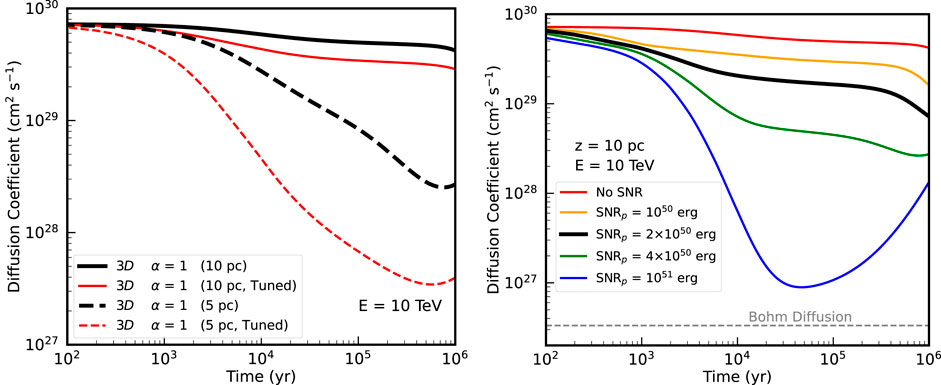
Figure 10. Electron–positron diffusion coefficients at 10 TeV from a 3D model of gamma-ray pulsar halo as a function of time (in yr). Left panel: Solutions at two distances: 10 pc (in black) and 5 pc (in red) for two different models (fiducial and tuned; see the text for details). Right panel: Solution at 10 pc, including the contribution of the SNR, for different total energy imparted into the proton component. From Mukhopadhyay and Linden (2022).
3 Dynamical effects associated with cosmic-ray release
As they carry momentum and pressure, CRs can provide some feedback over the ISM gas coupled to magnetic fields. These effects are expected to be even stronger, close to CR sources. In some sense, the previous section already treats the feedback effect through CR-driven instability. Here, we would like to focus more on recent numerical simulations addressing this effect in the context of multi-scale ISM dynamics.
3.1 Feedback from the CR-resonant streaming instability
This instability has been considered the main instability driving magnetic field turbulence in the ISM (Morlino, 2018; Blasi, 2019; Marcowith et al., 2021). Through this instability, CRs transfer their momenta into the background gas via the production of Alfvén waves and ultimately participate in heating the ISM (Wiener et al., 2013). Once they can trigger resonant magnetic fluctuations, CRs are rapidly locked to the gas (Skilling, 1971). Their bulk speed is the ambient Alfvén speed, or
The main application of this theory concerns the CR feedback in star formation through the sustaining of galactic winds. In effect, while driving the background gas in motion, CRs extract some gas from the galactic disk, lowering the star formation rate [see the review by Ruszkowski and Pfrommer (2023) and references therein]. This review is, however, restricted to smaller-than-kpc-scale ISM. The interested reader is referred to the above-mentioned review for details about CR-driven physics at larger galactic scales.
Around sources, the pressure gradient set by the onset of the CR streaming instability can have dynamical effects over the ambient gas because
where
In that situation, the CR gradient along the magnetic field lines is high enough to produce some feedback effects. This condition is true regardless of the ISM phase. If
3.2 CR current-driven feedback
Schroer et al. (2022) and Schroer et al. (2021) have considered a different scenario than the ones invoked in the framework of the CRC model. In their setup, CRs escaping the SNR can carry a current
which translates into
In Schroer et al. (2022) and Schroer et al. (2021), 2D and then 3D hybrid simulations are conducted where CRs are injected on a subpart of the left boundary to mimic the injection by an SNR into the magnetic flux tube. Figure 11 shows the evolution of the 3D morphology of the flux tube using the hybrid approach. The simulation setup respects the condition in Equation 9, even if the CR density is upscaled with respect to a realistic object. A clear inflation due to the lateral CR pressure effect can be noticed. The diffusion coefficient along the flux tube direction converges to a value a few times its Bohm limit. This work shows that while being injected around the SNR, CRs may modify the surrounding ISM gas and magnetic distribution. This effect should be accounted for while dealing with any gamma-ray halo morphology. However, the effective expansion of the flux tube in realistic situations is not clear at this stage. In effect, if only 10% of the mechanical energy is imparted into CRs at the position of the SNR, 90% is still available to inflate the magnetic flux tube. The inflation information propagates at a speed corresponding to the maximum between the local sound and the Alfvén speed. While moving ballistically, the CRs will reach regions of the flux tube far ahead, but as they start to trigger magnetic fluctuations, their mean speed slows to

Figure 11. 3D contour plots of CR density as a function of time (here in units of
Blasi and Amato (2019) propose a similar approach for the case of CRs escaping the galactic disc. CRs escape diffusively the galactic disc with a flux
3.3 CR pressure-driven feedback
By CR pressure-driven feedback, we mean the induced effects associated with second-order anisotropy in the CR distribution function (Bykov et al., 2014; Zweibel, 2020). Zweibel (2020) proposes an ensatz for the particle distribution function given by
where
where
4 Conclusion and perspectives
The advent of GeV and TeV gamma-ray detectors starts to shed light on the complex structure of our galaxy. It appears that the high-angular resolution capacity of Cherenkov imagers allows us to derive a gamma-ray profile around different classes of sources like supernova remnants, massive star clusters, and pulsar gamma-ray halos. In several cases, the radial profile is consistent with a 1/r scaling, which can be associated with a diffusive particle dilution. The profile width allows for constraining the amplitude of the diffusion coefficients, which is found to be reduced with respect to the values expected from diffusion laws reconstructed from secondary to primary CR ratios in direct measurements. One can then invoke some specific processes reducing the particle diffusivity around CR sources. However, the process of CR escape and propagation in the interstellar medium is still not a formally settled issue in modern astrophysics. This is largely due to a combination of complex effects that are difficult to handle with even the most powerful supercomputers. Escape traces the transition between in-source turbulence, which is often self-generated by the cosmic rays themselves, like in supernova remnants, to the propagation in the large-injected turbulence in the interstellar medium. One may then expect particles to first propagate along magnetic flux tubes over distances comparable to the background turbulence coherence length. In this framework, the CRC model describes the injection of a component of cosmic rays disconnected from their acceleration process. The particles, because they carry a pressure dominating the background gas and magnetic pressures, can trigger their own turbulence through various instabilities, among which the resonant streaming instability has been the most frequently investigated. The amplitude of the self-generated turbulence is controlled by different damping processes. The dominant damping mechanism depends on the phase of the interstellar medium surrounding the source. Globally, the cloud model predicts a reduction of cosmic-ray diffusivity by 1–2 orders of magnitude depending on the particle energy. Higher (TeV) CR energies are confined over shorter timescales than GeV particles. Below GeV, the self-generated waves may confine cosmic rays efficiently enough to impose a strong intermittency distribution.In addition to this progress, several aspects of the escape-close source propagation problem must be improved. On the observational side, it seems important to have a better assessment of CR content around sources, whatever its type. This probably requires a careful analysis of the surrounding emissions from molecular clouds or any dense material target (e.g., shells or HII regions). On the theoretical side, several aspects are worth considering. First, the factors that affect the interconnection between acceleration and escape must be understood to have a better description of the time evolution of the maximum particle energies and how they are connected to the injection. This aspect has not been effectively investigated because of the scale separation between the two processes. It appears that high-energy CRs, while accelerated, produce copious magnetic perturbations that participate in a strong corrugation of the shock front (van Marle et al., 2019). The corrugation modifies the local magnetic field orientation—or obliquity—with respect to the shock front, which itself impacts the injection efficiency of the whole shock acceleration process (Caprioli and Spitkovsky, 2014; van Marle et al., 2022). Now, this aspect has only been investigated over rather short timescales and usually in 2D because of high computational costs. It deserves an accurate description in 3D and over longer timescales to catch a possible self-similar particle injection-acceleration behaviour (Simon et al., 2024). Another aspect often overlooked in shock theory is that the ISM medium is all but homogeneous. Upstream density and magnetic fluctuations can impact the acceleration process itself (Xu and Lazarian, 2022b; Hu et al., 2022b). Second, once released, CRs can be subject to or be submitted to many effects, as discussed in this review. In reality, the physics is quite complex. The ISM is turbulent, and what we call phases is only an idealised view. For instance, as an SNR reaches scales like 1–10 pc in the galactic plane, the ambient medium can be diverse, and the view of a straight magnetic flux tube over 100 pc is certainly an oversimplification. Simulations combining phases or accounting for the magnetic flux tube distortion (Chandran, 2000) seem to be timely now. Another aspect is that until now, the CRC model investigated the non-linear modification of the particle transport only considering the perturbations produced by one CR component in energy: one can anticipate rather that the self-generated turbulence triggered by high-energy particles would interfere with the propagation of less-energetic particles released later. Finally, as invoked by Schroer et al. (2021), the dynamics of magnetic flux tubes can be strongly modified by the presence of CRs in overpressure with respect to the background magnetic plasma. All these aspects should be investigated to make substantial progress in that particular important field of cosmic-ray research.
Author contributions
AM: writing–original draft and writing–review and editing.
Funding
The author(s) declare that no financial support was received for the research, authorship, and/or publication of this article.
Acknowledgments
The author would like to thank S. Manconi, S. Recchia, and S. Xu for a careful reading of the manuscript and very valuable comments. The author thanks S. Gabici for enlightening discussions, particularly on the aspect of the development of the non-resonant streaming instability around SNRs. The author thanks ANR for support to the GAMALO project under reference ANR-19-CE31-0014. The author thanks IN2P3 for the support of the INTERCOS project.
Conflict of interest
The author declares that the research was conducted in the absence of any commercial or financial relationships that could be construed as a potential conflict of interest.
Publisher’s note
All claims expressed in this article are solely those of the authors and do not necessarily represent those of their affiliated organizations, or those of the publisher, the editors, and the reviewers. Any product that may be evaluated in this article, or claim that may be made by its manufacturer, is not guaranteed or endorsed by the publisher.
Footnotes
1https://www.theses.fr/2020MONTS048
2
References
Abeysekara, A. U., Albert, A., Alfaro, R., Alvarez, C., Camacho, J. R. A., Arteaga-Velázquez, J. C., et al. (2021). HAWC observations of the acceleration of very-high-energy cosmic rays in the Cygnus Cocoon. Nat. Astron. 5, 465–471. doi:10.1038/s41550-021-01318-y
Aharonian, F., Ashkar, H., Backes, M., Barbosa Martins, V., Becherini, Y., Berge, D., et al. (2022). A deep spectromorphological study of the γ-ray emission surrounding the young massive stellar cluster Westerlund 1. A& 666, A124. doi:10.1051/0004-6361/202244323
Aharonian, F., Yang, R., and de Oña Wilhelmi, E. (2019). Massive stars as major factories of Galactic cosmic rays. Nat. Astron. 3, 561–567. doi:10.1038/s41550-019-0724-0
Aloisio, R., and Blasi, P. (2013). Propagation of galactic cosmic rays in the presence of self-generated turbulence. JCAP 2013, 001. doi:10.1088/1475-7516/2013/07/001
Aloisio, R., Blasi, P., and Serpico, P. D. (2015). Nonlinear cosmic ray Galactic transport in the light of AMS-02 and Voyager data. A& 583, A95. doi:10.1051/0004-6361/201526877
Amato, E., and Blasi, P. (2009). A kinetic approach to cosmic-ray-induced streaming instability at supernova shocks. MNRAS 392, 1591–1600. doi:10.1111/j.1365-2966.2008.14200.x
Bell, A. R. (2004). Turbulent amplification of magnetic field and diffusive shock acceleration of cosmic rays. MNRAS 353, 550–558. doi:10.1111/j.1365-2966.2004.08097.x
Bell, A. R., Schure, K. M., Reville, B., and Giacinti, G. (2013). Cosmic-ray acceleration and escape from supernova remnants. MNRAS 431, 415–429. doi:10.1093/mnras/stt179
Beresnyak, A. (2013). Asymmetric diffusion of magnetic field lines. ApJl 767, L39. doi:10.1088/2041-8205/767/2/L39
Blandford, R., Simeon, P., Globus, N., Mukhopadhyay, P., Peretti, E., and Barrow, K. S. S. (2023). “A hierarchical framework for explaining the cosmic ray spectrum using diffusive shock acceleration,” in 38th ICRC conference, Nagoya, Japan. arXiv:2309.09116doi. doi:10.48550/arXiv.2309.09116
Blasi, P., and Amato, E. (2019). Escape of cosmic rays from the galaxy and effects on the circumgalactic medium. PRL 122, 051101. doi:10.1103/PhysRevLett.122.051101
Brahimi, L., Marcowith, A., and Ptuskin, V. S. (2020). Nonlinear diffusion of cosmic rays escaping from supernova remnants: Cold partially neutral atomic and molecular phases. A& 633, A72. doi:10.1051/0004-6361/201936166
Brose, R., Pohl, M., Sushch, I., Petruk, O., and Kuzyo, T. (2020). Cosmic-ray acceleration and escape from post-adiabatic supernova remnants. A& 634, A59. doi:10.1051/0004-6361/201936567
Brose, R., Telezhinsky, I., and Pohl, M. (2016). Transport of magnetic turbulence in supernova remnants. A& 593, A20. doi:10.1051/0004-6361/201527345
Bykov, A. M., Brandenburg, A., Malkov, M. A., and Osipov, S. M. (2014). “Microphysics of cosmic ray driven plasma instabilities,”. Microphysics of cosmic plasmas. Editors A. Balogh, A. Bykov, P. Cargill, R. Dendy, T. Dudok de Wit, and J. Raymond, 125, 125–156. doi:10.1007/978-1-4899-7413-6_6
Bykov, A. M., Ellison, D. C., and Osipov, S. M. (2017). Nonlinear Monte Carlo model of superdiffusive shock acceleration with magnetic field amplification. PRE 95, 033207. doi:10.1103/PhysRevE.95.033207
Bykov, A. M., Marcowith, A., Amato, E., Kalyashova, M. E., Kruijssen, J. M. D., and Waxman, E. (2020). High-energy particles and radiation in star-forming regions. Space Sci. Rev. 216, 42. doi:10.1007/s11214-020-00663-0
Caprioli, D., and Spitkovsky, A. (2014). Simulations of ion acceleration at non-relativistic shocks. I. Acceleration efficiency. ApJ 783, 91. doi:10.1088/0004-637X/783/2/91
Casse, F., Lemoine, M., and Pelletier, G. (2001). Transport of cosmic rays in chaotic magnetic fields. PRD 65, 023002. doi:10.1103/PhysRevD.65.023002
Celli, S., Morlino, G., Gabici, S., and Aharonian, F. A. (2019). Exploring particle escape in supernova remnants through gamma rays. MNRAS 490, 4317–4333. doi:10.1093/mnras/stz2897
Cerri, S. S. (2024). Revisiting the role of cosmic-ray driven Alfvén waves in pre-existing magnetohydrodynamic turbulence. I. Turbulent damping rates and feedback on background fluctuations. arXiv e-prints, arXiv:2402, 02901doi. doi:10.48550/arXiv.2402.02901
Chandran, B. D. G. (2000). Confinement and isotropization of galactic cosmic rays by molecular-cloud magnetic mirrors when turbulent scattering is weak. ApJ 529, 513–535. doi:10.1086/308232
Chepurnov, A., and Lazarian, A. (2010). Extending the big power law in the sky with turbulence spectra from Wisconsin hα mapper data. ApJ 710, 853–858. doi:10.1088/0004-637X/710/1/853
Commerçon, B., Marcowith, A., and Dubois, Y. (2019). Cosmic-ray propagation in the bi-stable interstellar medium. I. Conditions for cosmic-ray trapping. A& 622, A143. doi:10.1051/0004-6361/201833809
Cox, D. P. (2005). The three-phase interstellar medium revisited. Annu. Rev. A& 43, 337–385. doi:10.1146/annurev.astro.43.072103.150615
D’Angelo, M., Blasi, P., and Amato, E. (2016). Grammage of cosmic rays around Galactic supernova remnants. PRD 94, 083003. doi:10.1103/PhysRevD.94.083003
Dewar, R. L. (1970). Interaction between hydromagnetic waves and a time-dependent, inhomogeneous medium. Phys. Fluids 13, 2710–2720. doi:10.1063/1.1692854
Diesing, R., Guo, M., Kim, C.-G., Stone, J., and Caprioli, D. (2024). Nonthermal signatures of radiative supernova remnants. arXiv e-prints , arXiv:2404.15396 974, 201. doi:10.3847/1538-4357/ad74f0
Drury, L. O. (2011). Escaping the accelerator: how, when and in what numbers do cosmic rays get out of supernova remnants? MNRAS 415, 1807–1814. doi:10.1111/j.1365-2966.2011.18824.x
Dubois, Y., Commerçon, B., Marcowith, A., and Brahimi, L. (2019). Shock-accelerated cosmic rays and streaming instability in the adaptive mesh refinement code Ramses. 631, A121. doi:10.1051/0004-6361/201936275
Evoli, C., Linden, T., and Morlino, G. (2018). Self-generated cosmic-ray confinement in TeV halos: implications for TeV γ-ray emission and the positron excess. PRD 98, 063017. doi:10.1103/PhysRevD.98.063017
Eyink, G. L., Lazarian, A., and Vishniac, E. T. (2011). Fast magnetic reconnection and spontaneous stochasticity. ApJ 743, 51. doi:10.1088/0004-637X/743/1/51
Fang, K. (2022). Gamma-ray pulsar halos in the Galaxy. Front. Astronomy Space Sci. 9, 1022100. doi:10.3389/fspas.2022.1022100
Farmer, A. J., and Goldreich, P. (2004). Wave damping by magnetohydrodynamic turbulence and its effect on cosmic-ray propagation in the interstellar medium. ApJ 604, 671–674. doi:10.1086/382040
Fujita, Y., Takahara, F., Ohira, Y., and Iwasaki, K. (2011). Alfvén wave amplification and self-containment of cosmic rays escaping from a supernova remnant. MNRAS 415, 3434–3438. doi:10.1111/j.1365-2966.2011.18980.x
Funk, S. (2015). Ground- and space-based gamma-ray astronomy. Annu. Rev. Nucl. Part. Sci. 65, 245–277. doi:10.1146/annurev-nucl-102014-022036
Gabici, S., Evoli, C., Gaggero, D., Lipari, P., Mertsch, P., Orlando, E., et al. (2019). The origin of Galactic cosmic rays: challenges to the standard paradigm. Int. J. Mod. Phys. D 28, 1930022–1930339. doi:10.1142/S0218271819300222
Génolini, Y., Boudaud, M., Batista, P. I., Caroff, S., Derome, L., Lavalle, J., et al. (2019). Cosmic-ray transport from AMS-02 boron to carbon ratio data: benchmark models and interpretation. PRD 99, 123028. doi:10.1103/PhysRevD.99.123028
Giacinti, G., Mitchell, A. M. W., López-Coto, R., Joshi, V., Parsons, R. D., and Hinton, J. A. (2020). Halo fraction in TeV-bright pulsar wind nebulae. A& 636, A113. doi:10.1051/0004-6361/201936505
Grenier, I. A., Black, J. H., and Strong, A. W. (2015). The nine lives of cosmic rays in galaxies. Annu. Rev. A& 53, 199–246. doi:10.1146/annurev-astro-082214-122457
Hanabata, Y., Katagiri, H., Hewitt, J. W., Ballet, J., Fukazawa, Y., Fukui, Y., et al. (2014). Detailed investigation of the gamma-ray emission in the vicinity of SNR W28 with FERMI-LAT. ApJ 786, 145. doi:10.1088/0004-637X/786/2/145
Hasegawa, A. (1975). Plasma instabilities and nonlinear effects, 8. Springer Verlag Springer Series on Physics Chemistry Space.
Haverkorn, M., Brown, J. C., Gaensler, B. M., and McClure-Griffiths, N. M. (2008). The outer scale of turbulence in the magnetoionized galactic interstellar medium. ApJ 680, 362–370. doi:10.1086/587165
Hennebelle, P., and Falgarone, E. (2012). Turbulent molecular clouds. A&Rev 20, 55. doi:10.1007/s00159-012-0055-y
Hollweg, J. V. (1971). Nonlinear Landau damping of Alfvén waves. PRL 27, 1349–1352. doi:10.1103/PhysRevLett.27.1349
Hu, Y., Lazarian, A., and Xu, S. (2022a). Superdiffusion of cosmic rays in compressible magnetized turbulence. MNRAS 512, 2111–2124. doi:10.1093/mnras/stac319
Hu, Y., Xu, S., Stone, J. M., and Lazarian, A. (2022b). Turbulent magnetic field amplification by the interaction of a shock wave and inhomogeneous medium. ApJ 941, 133. doi:10.3847/1538-4357/ac9ebc
Jacobs, H., Mertsch, P., and Phan, V. H. M. (2022). Self-confinement of low-energy cosmic rays around supernova remnants. JCAP 2022, 024. doi:10.1088/1475-7516/2022/05/024
Jean, P., Gillard, W., Marcowith, A., and Ferrière, K. (2009). Positron transport in the interstellar medium. A& 508, 1099–1116. doi:10.1051/0004-6361/200809830
Kamijima, S. F., and Ohira, Y. (2021). Escape of cosmic rays from perpendicular shocks in the interstellar magnetic field. PRD 104, 083028. doi:10.1103/PhysRevD.104.083028
Kamijima, S. F., and Ohira, Y. (2022). Escape of cosmic rays from perpendicular shocks in the circumstellar magnetic field. PRD 106, 123025. doi:10.1103/PhysRevD.106.123025
Katagiri, H., Yoshida, K., Ballet, J., Grondin, M. H., Hanabata, Y., Hewitt, J. W., et al. (2016). Fermi LAT discovery of extended gamma-ray emissions in the vicinity of the HB 3 supernova remnant. ApJ 818, 114. doi:10.3847/0004-637X/818/2/114
Kempski, P., Fielding, D. B., Quataert, E., Galishnikova, A. K., Kunz, M. W., Philippov, A. A., et al. (2023). Cosmic ray transport in large-amplitude turbulence with small-scale field reversals. MNRAS 525, 4985–4998. doi:10.1093/mnras/stad2609
Kulsrud, R., and Pearce, W. P. (1969). The effect of wave-particle interactions on the propagation of cosmic rays. ApJ 156, 445. doi:10.1086/149981
Larson, R. B. (1979). Stellar kinematics and interstellar turbulence. MNRAS 186, 479–490. doi:10.1093/mnras/186.3.479
Larson, R. B. (1981). Turbulence and star formation in molecular clouds. MNRAS 194, 809–826. doi:10.1093/mnras/194.4.809
Lazarian, A. (2016). Damping of Alfvén waves by turbulence and its consequences: from cosmic-ray streaming to launching winds. ApJ 833, 131. doi:10.3847/1538-4357/833/2/131
Lazarian, A., and Beresnyak, A. (2006). Cosmic ray scattering in compressible turbulence. MNRAS 373, 1195–1202. doi:10.1111/j.1365-2966.2006.11093.x
Lazarian, A., and Xu, S. (2021). Diffusion of cosmic rays in MHD turbulence with magnetic mirrors. ApJ 923, 53. doi:10.3847/1538-4357/ac2de9
Lazarian, A., and Yan, H. (2014). Superdiffusion of cosmic rays: implications for cosmic ray acceleration. ApJ 784, 38. doi:10.1088/0004-637X/784/1/38
Lee, M. A., and Völk, H. J. (1973). Damping and non-linear wave-particle interactions of alfvén-waves in the solar wind. Astr. Sp.Sc 24, 31–49. doi:10.1007/BF00648673
Lemoine, M. (2023). Particle transport through localized interactions with sharp magnetic field bends in MHD turbulence. J. Plasma Phys. 89, 175890501. doi:10.1017/S0022377823000946
Li, Y., Xin, Y., Liu, S., and He, Y. (2023). Advanced γ-ray emission studies of G15.4+0.1 with fermi-LAT: evidence of escaping cosmic rays interacting with surrounding molecular clouds. ApJ 945, 21. doi:10.3847/1538-4357/acb81d
Liu, R.-Y. (2022). The physics of pulsar halos: research progress and prospect. Int. J. Mod. Phys. A 37, 2230011. doi:10.1142/S0217751X22300113
López-Coto, R., de Oña Wilhelmi, E., Aharonian, F., Amato, E., and Hinton, J. (2022). Gamma-ray haloes around pulsars as the key to understanding cosmic-ray transport in the Galaxy. Nat. Astron. 6, 199–206. doi:10.1038/s41550-021-01580-0
López-Coto, R., and Giacinti, G. (2018). Constraining the properties of the magnetic turbulence in the Geminga region using HAWC γ-ray data. MNRAS 479, 4526–4534. doi:10.1093/mnras/sty1821
MAGIC Collaboration Acciari, V. A., Ansoldi, S., Antonelli, L. A., Artero, M., Asano, K., et al. (2023). Study of the GeV to TeV morphology of the γ Cygni SNR (G 78.2+2.1) with MAGIC and Fermi-LAT. Evidence for cosmic ray escape. A& 670, A8. doi:10.1051/0004-6361/202038748
Makino, K., Fujita, Y., Nobukawa, K. K., Matsumoto, H., and Ohira, Y. (2019). Interaction between molecular clouds and MeV-TeV cosmic-ray protons escaped from supernova remnants. PASJ 71, 78. doi:10.1093/pasj/psz058
Malik, S., Yuen, K. H., and Yan, H. (2023). Diagnosis of 3D magnetic field and mode composition in MHD turbulence with Y-parameter. MNRAS 524, 6102–6113. doi:10.1093/mnras/stad2225
Malkov, M. A., Diamond, P. H., Sagdeev, R. Z., Aharonian, F. A., and Moskalenko, I. V. (2013). Analytic solution for self-regulated collective escape of cosmic rays from their acceleration sites. ApJ 768, 73. doi:10.1088/0004-637X/768/1/73
Marcowith, A. (2023). Cosmic-Ray-modified and driven instabilities. arXiv e-prints. arXiv:2312.17134doi. doi:10.48550/arXiv.2312.17134
Marcowith, A., Ferrand, G., Grech, M., Meliani, Z., Plotnikov, I., and Walder, R. (2020). Multi-scale simulations of particle acceleration in astrophysical systems. Living Rev. Comput. Astrophysics 6, 1. doi:10.1007/s41115-020-0007-6
Marcowith, A., van Marle, A. J., and Plotnikov, I. (2021). The cosmic ray-driven streaming instability in astrophysical and space plasmas. Phys. Plasmas 28, 080601. doi:10.1063/5.0013662
McKee, C. F., and Ostriker, J. P. (1977). A theory of the interstellar medium: three components regulated by supernova explosions in an inhomogeneous substrate. ApJ 218, 148–169. doi:10.1086/155667
Mitchell, A. M. W., Rowell, G. P., Celli, S., and Einecke, S. (2021). Using interstellar clouds to search for Galactic PeVatrons: gamma-ray signatures from supernova remnants. MNRAS 503, 3522–3539. doi:10.1093/mnras/stab667
Morlino, G. (2018). Effects of self-generated turbulence on Galactic Cosmic Ray propagation and associated diffuse γ-ray emission. Nucl. Part. Phys. Proc. 297-299, 39–48. doi:10.1016/j.nuclphysbps.2018.07.006
Mukhopadhyay, P., and Linden, T. (2022). Self-generated cosmic-ray turbulence can explain the morphology of TeV halos. PRD 105, 123008. doi:10.1103/PhysRevD.105.123008
Nava, L., and Gabici, S. (2013). Anisotropic cosmic ray diffusion and gamma-ray production close to supernova remnants, with an application to W28. MNRAS 429, 1643–1651. doi:10.1093/mnras/sts450
Nava, L., Gabici, S., Marcowith, A., Morlino, G., and Ptuskin, V. S. (2016). Non-linear diffusion of cosmic rays escaping from supernova remnants - I. The effect of neutrals. MNRAS 461, 3552–3562. doi:10.1093/mnras/stw1592
Nava, L., Recchia, S., Gabici, S., Marcowith, A., Brahimi, L., and Ptuskin, V. (2019). Non-linear diffusion of cosmic rays escaping from supernova remnants - II. Hot ionized media. MNRAS 484, 2684–2691. doi:10.1093/mnras/stz137
Neufeld, D. A., Wolfire, M. G., and Schilke, P. (2005). The chemistry of fluorine-bearing molecules in diffuse and dense interstellar gas clouds. ApJ 628, 260–274. doi:10.1086/430663
Ohira, Y., Murase, K., and Yamazaki, R. (2011). Gamma-rays from molecular clouds illuminated by cosmic rays escaping from interacting supernova remnants. MNRAS 410, 1577–1582. doi:10.1111/j.1365-2966.2010.17539.x
Oka, T., and Ishizaki, W. (2022). Detection of gamma-rays around SNR HB9 and its implications for the diffusive shock-acceleration history. PASJ 74, 625–638. doi:10.1093/pasj/psac024
Padovani, M., Galli, D., and Glassgold, A. E. (2009). Cosmic-ray ionization of molecular clouds. A& 501, 619–631. doi:10.1051/0004-6361/200911794
Padovani, M., Ivlev, A. V., Galli, D., Offner, S. S. R., Indriolo, N., Rodgers-Lee, D., et al. (2020). Impact of low-energy cosmic rays on star formation. Space Sci. Rev. 216, 29. doi:10.1007/s11214-020-00654-1
Peron, G., Aharonian, F., Casanova, S., Zanin, R., and Romoli, C. (2020). On the gamma-ray emission of W44 and its surroundings. ApJL 896, L23. doi:10.3847/2041-8213/ab93d1
Petrosian, V., and Chen, Q. (2014). Determination of acceleration mechanism characteristics directly and nonparametrically from observations: application to supernova remnants. PRD 89, 103007. doi:10.1103/PhysRevD.89.103007
Phan, V. H. M., Recchia, S., Mertsch, P., and Gabici, S. (2023). Stochasticity of cosmic rays from supernova remnants and the ionization rates in molecular clouds. PRD 107, 123006. doi:10.1103/PhysRevD.107.123006
Ptuskin, V. S., Strelnikova, O. N., and Sveshnikova, L. G. (2009). On leaky-box approximation to GALPROP. Astropart. Phys. 31, 284–289. doi:10.1016/j.astropartphys.2009.02.004
Ptuskin, V. S., and Zirakashvili, V. N. (2005). On the spectrum of high-energy cosmic rays produced by supernova remnants in the presence of strong cosmic-ray streaming instability and wave dissipation. A& 429, 755–765. doi:10.1051/0004-6361:20041517
Ptuskin, V. S., Zirakashvili, V. N., and Plesser, A. A. (2008). Non-linear diffusion of cosmic rays. Adv. Space Res. 42, 486–490. doi:10.1016/j.asr.2007.12.007
Recchia, S., Galli, D., Nava, L., Padovani, M., Gabici, S., Marcowith, A., et al. (2022). Grammage of cosmic rays in the proximity of supernova remnants embedded in a partially ionized medium. A& 660, A57. doi:10.1051/0004-6361/202142558
Reville, B., Bell, A. R., and Gregori, G. (2013). Diffusive shock acceleration at laser-driven shocks: studying cosmic-ray accelerators in the laboratory. New J. Phys. 15, 015015. doi:10.1088/1367-2630/15/1/015015
Reville, B., Giacinti, G., and Scott, R. (2021). Cosmic-ray current-driven instabilities - revisiting environmental conditions. MNRAS 502, 4137–4153. doi:10.1093/mnras/stab296
Reville, B., Kirk, J. G., and Duffy, P. (2009). Steady-state solutions in nonlinear diffusive shock acceleration. ApJ 694, 951–958. doi:10.1088/0004-637X/694/2/951
Roy, N., Peedikakkandy, L., and Chengalur, J. N. (2008). Turbulence measurements from HI absorption spectra. MNRAS 387, L18–L22. doi:10.1111/j.1745-3933.2008.00473.x
Ruszkowski, M., and Pfrommer, C. (2023). Cosmic ray feedback in galaxies and galaxy clusters. A&Rev 31, 4. doi:10.1007/s00159-023-00149-2
Ruszkowski, M., Yang, H. Y. K., and Reynolds, C. S. (2017). Cosmic-ray feedback heating of the intracluster medium. ApJ 844, 13. doi:10.3847/1538-4357/aa79f8
Schroer, B., Pezzi, O., Caprioli, D., Haggerty, C., and Blasi, P. (2021). Dynamical effects of cosmic rays on the medium surrounding their sources. ApJL 914, L13. doi:10.3847/2041-8213/ac02cd
Schroer, B., Pezzi, O., Caprioli, D., Haggerty, C. C., and Blasi, P. (2022). Cosmic-ray generated bubbles around their sources. MNRAS 512, 233–244. doi:10.1093/mnras/stac466
Schwartz, S. J., and Skilling, J. (1978). The escape of cosmic rays from supernova remnants. A&A 70, 607.
Shalchi, A. (2005). Second-order quasilinear theory of cosmic ray transport. Phys. Plasmas 12, 052905. doi:10.1063/1.1895805
Shukurov, A., Snodin, A. P., Seta, A., Bushby, P. J., and Wood, T. S. (2017). Cosmic rays in intermittent magnetic fields. ApJl 839, L16. doi:10.3847/2041-8213/aa6aa6
Simon, E., Caprioli, D., Haggerty, C., and Reville, B. (2024). Maximum energy achievable in supernova remnants: self-consistent simulations. arXiv e-prints, arXiv:2402, 01048doi. doi:10.48550/arXiv.2402.01048
Skilling, J. (1971). Cosmic rays in the galaxy: convection or diffusion? ApJ 170, 265. doi:10.1086/151210
Skilling, J. (1975). Cosmic ray streaming - II. Effect of particles on Alfvén waves. MNRAS 173, 245–254. doi:10.1093/mnras/173.2.245
Snow, T. P., and McCall, B. J. (2006). Diffuse atomic and molecular clouds. Annu. Rev. A& 44, 367–414. doi:10.1146/annurev.astro.43.072103.150624
Tatischeff, V. (2003). “X- and gamma-ray line emission processes,”. EAS publications series. Editors C. Motch, and J.-M. Hameury (Aussois, France: 7 of EAS Publications Series), 79, 79. doi:10.1051/eas:2003038
Telezhinsky, I., Dwarkadas, V. V., and Pohl, M. (2012). Time-dependent escape of cosmic rays from supernova remnants, and their interaction with dense media. A& 541, A153. doi:10.1051/0004-6361/201118639
Tibaldo, L., Gaggero, D., and Martin, P. (2021). Gamma rays as probes of cosmic-ray propagation and interactions in galaxies. Universe 7, 141. doi:10.3390/universe7050141
Truelove, J. K., and McKee, C. F. (1999). Evolution of nonradiative supernova remnants. ApJs 120, 299–326. doi:10.1086/313176
Uchiyama, Y., Funk, S., Katagiri, H., Katsuta, J., Lemoine-Goumard, M., Tajima, H., et al. (2012). Fermi large area telescope discovery of GeV gamma-ray emission from the vicinity of SNR W44. ApJL 749, L35. doi:10.1088/2041-8205/749/2/L35
van Marle, A. J., Bohdan, A., Morris, P. J., Pohl, M., and Marcowith, A. (2022). Diffusive shock acceleration at oblique high Mach number shocks. ApJ 929, 7. doi:10.3847/1538-4357/ac5962
van Marle, A. J., Casse, F., and Marcowith, A. (2019). Three-dimensional simulations of non-resonant streaming instability and particle acceleration near non-relativistic astrophysical shocks. MNRAS 490, 1156–1165. doi:10.1093/mnras/stz2624
Vink, J., and Bamba, A. (2022). “Nonthermal processes and particle acceleration in supernova remnants,” in Handbook of X-ray and gamma-ray Astrophysics (Springer), 52. doi:10.1007/978-981-16-4544-0_90-1
Weidl, M. S., Jenko, F., Teaca, B., and Schlickeiser, R. (2015). Cosmic-ray pitch-angle scattering in imbalanced MHD turbulence simulations. ApJ 811, 8. doi:10.1088/0004-637X/811/1/8
Wiener, J., Zweibel, E. G., and Oh, S. P. (2013). Cosmic ray heating of the warm ionized medium. ApJ 767, 87. doi:10.1088/0004-637X/767/1/87
Xin, Y., and Guo, X. (2023). Detection of the extended γ-ray emission around supernova remnant DA 530 with fermi-LAT. ApJ 955, 84. doi:10.3847/1538-4357/acf455
Xu, S. (2021). Mirror diffusion of cosmic rays in highly compressible turbulence near supernova remnants. ApJ 922, 264. doi:10.3847/1538-4357/ac2d8f
Xu, S., and Lazarian, A. (2022a). Cosmic ray streaming in the turbulent interstellar medium. ApJ 927, 94. doi:10.3847/1538-4357/ac4dfd
Xu, S., and Lazarian, A. (2022b). Shock acceleration with oblique and turbulent magnetic fields. ApJ 925, 48. doi:10.3847/1538-4357/ac3824
Xu, S., Lazarian, A., and Yan, H. (2015). The line width difference of neutrals and ions induced by MHD turbulence. ApJ 810, 44. doi:10.1088/0004-637X/810/1/44
Yan, H., and Lazarian, A. (2004). Cosmic-ray scattering and streaming in compressible magnetohydrodynamic turbulence. ApJ 614, 757–769. doi:10.1086/423733
Yan, H., Lazarian, A., and Schlickeiser, R. (2012). Cosmic-ray streaming from supernova remnants and gamma-ray emission from nearby molecular clouds. ApJ 745, 140. doi:10.1088/0004-637X/745/2/140
Yang, C., Zhang, L., and Wang, J. (2015). On the escape and propagation of high-energy protons near young supernova remnants. MNRAS 448, 3423–3428. doi:10.1093/mnras/stv255
Zhang, C., and Xu, S. (2023). Numerical testing of mirror diffusion of cosmic rays. ApJL 959, L8. doi:10.3847/2041-8213/ad0fe5
Zirakashvili, V. N., and Ptuskin, V. S. (2012). Numerical simulations of diffusive shock acceleration in SNRs. Astropart. Phys. 39, 12–21. doi:10.1016/j.astropartphys.2011.09.003
Zweibel, E. G. (2013). The microphysics and macrophysics of cosmic rays. Phys. Plasmas 20, 055501. doi:10.1063/1.4807033
Zweibel, E. G. (2020). The role of pressure anisotropy in cosmic-ray hydrodynamics. ApJ 890, 67. doi:10.3847/1538-4357/ab67bf
Keywords: cosmic rays, acceleration process, interstellar medium, instabilities, turbulence
Citation: Marcowith A (2025) Cosmic rays escape from their sources. Front. Astron. Space Sci. 11:1411076. doi: 10.3389/fspas.2024.1411076
Received: 02 April 2024; Accepted: 17 October 2024;
Published: 08 January 2025.
Edited by:
Siyao Xu, University of Florida, United StatesReviewed by:
Siming Liu, Southwest Jiaotong University, ChinaYue Hu, The Institute for Advanced Study (IAS), United States
Copyright © 2025 Marcowith. This is an open-access article distributed under the terms of the Creative Commons Attribution License (CC BY). The use, distribution or reproduction in other forums is permitted, provided the original author(s) and the copyright owner(s) are credited and that the original publication in this journal is cited, in accordance with accepted academic practice. No use, distribution or reproduction is permitted which does not comply with these terms.
*Correspondence: A. Marcowith, QWxleGFuZHJlLk1hcmNvd2l0aEB1bW9udHBlbGxpZXIuZnI=
 A. Marcowith
A. Marcowith